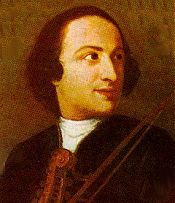Giuseppe Tartini Biography - A Very Quick Guide
Artist:
Giuseppe Tartini
Born:
April 8, 1692
Died:
February 26, 1770
Giuseppe Tartini (April 8, 1692 – February 26, 1770) was an Italian composer and violinist born in Piran, Istria (now Slovenia). Initially intended for the Franciscan priesthood, he received basic musical training before studying law at the University of Padua, where he also excelled at fencing. After his father’s death he secretly married Elisabetta Premazore—an act that angered the influential Cardinal Cornaro, forcing Tartini to flee to the convent of St. Francis in Assisi. There he began to study the violin seriously.
According to legend, hearing Francesco Maria Veracini perform in 1716 pushed Tartini to retreat to Ancona for intensive practice. His technique advanced dramatically, and by 1721 he became Kapellmeister at Il Santo in Padua, a post he held for much of his life. He later founded a renowned violin school that drew students from across Europe. Tartini also became deeply engaged in music theory, publishing several treatises from the 1750s onward.
Tartini is best known for the Devil's Trill Sonata, a virtuosic work inspired by a dream (so he claimed) in which the Devil played the violin at his bedside. Most of his output consists of violin concertos and sonatas; he wrote no operas or church music. His manuscripts pose challenges for scholars because he rarely dated them and frequently revised earlier works. As a theorist, Tartini made important contributions to acoustics, particularly his identification of combination tones, described in his Trattato di musica secondo la vera scienza dell’armonia (1754).
According to legend, hearing Francesco Maria Veracini perform in 1716 pushed Tartini to retreat to Ancona for intensive practice. His technique advanced dramatically, and by 1721 he became Kapellmeister at Il Santo in Padua, a post he held for much of his life. He later founded a renowned violin school that drew students from across Europe. Tartini also became deeply engaged in music theory, publishing several treatises from the 1750s onward.
Tartini is best known for the Devil's Trill Sonata, a virtuosic work inspired by a dream (so he claimed) in which the Devil played the violin at his bedside. Most of his output consists of violin concertos and sonatas; he wrote no operas or church music. His manuscripts pose challenges for scholars because he rarely dated them and frequently revised earlier works. As a theorist, Tartini made important contributions to acoustics, particularly his identification of combination tones, described in his Trattato di musica secondo la vera scienza dell’armonia (1754).
Top Pieces on 8notes by Giuseppe Tartini
